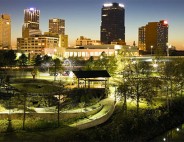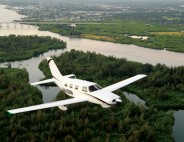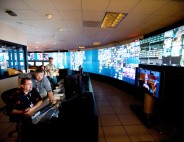Washington is Flying High in a Recovery Mode
22 Nov, 2013
By David Hodes
The economic engine in Washington is in full throttle once again and taking off.
Mary Trimarco, the assistant director of the business services division for the Washington State Department of Commerce, says that Gov. Jay Inslee’s economic strategy is about strengthening the state’s sector focus. “He is developing offices for sector lead resourcing for aerospace, information communications technology, advanced manufacturing, life sciences, maritime, military and agriculture,” she says.
Of those sectors, there has been a lot of activity in aerospace, much of it stemming from the recent department’s trade mission to the 50th Paris Air Show in mid-June, part of a 51-member delegation from the state doing aggressive face-to-face meetings during the show about business recruitment, procurement, expansion and foreign investment opportunities.
Trimarco says that show generated $34 million in export sales so far because of the interest in Washington’s aerospace sector, with a forecast for a total of $65 million. “Last year we did $200 million in assisted sales, direct assisted documented sales in aerospace,” she says. “And from that we projected another $200 million for this year.”
Trimarco says that they are going to work with their sector leads — especially aerospace — to develop strategies for venture investment funds, which are now going through exemption and reporting changes in the state. “The area we have to work through is the merger and acquisitions (M&A) piece,” she says. “There is a lot of interest in the M&A side of things to help companies from China and India get a reach into the U.S. market. So we are navigating through that.”
The governor will now be going to a mission to China later this year, after a successful mission to India last year. “We are pursuing an aggressive China strategy because there is a lot of investment coming out of China that needs to be cultivated,” Trimarco says. “There is a lot of interest in being in the U.S., and these trade missions have been a top priority for my department.”
In addition to aerospace, Trimarco says there has been a lot of interest out of Europe and other countries in food processing. “We see some of that agriculture interest particularly on the dairy side out of China.”
Industries and Innovation
Carl Adrian, president and CEO of the Tri-City Development Council composed of the Kennewick-Pasco and Richland MSA located between Portland and Seattle, says that their large agricultural presence accounts for “about one in 10” food processing jobs in the state.
The region’s economy is anchored in agriculture, bio and high technology, manufacturing, service industry and government. Major employers include Battelle/Pacific Northwest National Laboratory, URS, CH2M Hill, ConAgra Foods Lamb Weston, Bechtel National, Kadlec Medical Center, Amazon.com, Tyson Fresh Meats, and Lockheed Martin.
Farms cover a little more than a million acres in the tri-city area of Benton and Franklin counties; potatoes, wheat, apples, grapes, alfalfa, strawberries, asparagus, corn and hops are the largest producers here. “We are working to encourage further processing, like potatoes into pot pies,” Adrian says.
The area is the center of wine production in the state, which is currently ranked the second largest premium wine producer in the country with more than 750 different wineries and a total economic impact of $8.6 billion, according to the Washington Wine Commission. To take advantage of that, Washington State University in Richland recently broke ground on a 39,300-square-foot wine teaching facility, the Wine Science Center.
In the city of Sea-Tac (a suburb of both Seattle and Tacoma), Jeff Robinson, economic development manager for the city, says that Graham Trucking Inc., a regional trucking operation, recently moved its headquarters to a vacant rental car facility just south of the Seattle-Tacoma International Airport. That business will bring about 100 new jobs to the city, Robinson says.
Other logistics companies that have been settling and thriving in the area include the Japanese conglomerate company Kintetsu World Express Inc., and Jetstream Freight Forwarding Inc., founded in Seattle in 1997. The city is also promoting mixed use development surrounding their current and future light rail development. “We would like to see our transit oriented development sites coming out of the ground with Class A office space, plus some light industrial or fabrication plants,” Robinson says. Transit oriented development in these areas will include multi-family residential, offices, retail, restaurants, entertainment venues and hotels.
Talent and Education
Trimarco says that workforce development is a number one priority, not just in Washington but across the country. “It’s not just about new companies coming in,” she says. “It’s about the existing workforce because so much is changing. So you have to have a super nimble and super smart workforce.”
One way the state is doing that is the Running Start program that allows 11th and 12th grade students to take college courses at Washington’s 34 community and technical colleges, Washington State University, Eastern Washington University, Central Washington University and the Evergreen State College.
Students receive both high school and college credit for these classes.
In mid-2012, the Washington State Department of Commerce created a new university-focused venture fund, the W Fund, with the goal of investing approximately $20 million during the next four years in promising startups spinning out of the University of Washington and other research institutions across the state. The fund is expected to help advance the UW’s commercialization initiative, which aims to double the number of new companies created at the university over the next three years.
Assets
One of the largest employers in the city of Sea-Tac is the Port of Seattle, the largest port in the state and the eighth-busiest seaport in the country, with cargo activity that supports more than 21,000 jobs. The annual report for the port indicated that the port will add 100,000 jobs during the next 25 years.
The Port of Seattle also operates the international airport, the country’s 15th busiest, handling 33.2 million passengers last year.
Other infrastructure assets include 7,000 miles of state highways in Washington, including U.S. interstates 5 (the main north-south route between Portland, Oregon and Vancouver and the busiest in the state), 82 (an east-west route through the state between Seattle, Boise, Idaho, and Salt Lake City, Utah) and 90 (another east-west route that connects Seattle and Spokane).
Lifestyle
The lifestyle of the state can be very laid back, with plenty of hiking and outdoor activity in and around the lush rain forests and ocean beaches, along with a relatively constant supply of rain (20 to 40 inches per year in most places; more than 100 inches nearer to the coast) and a generally temperate weather pattern.
The cost of living can be challenging in and around the larger Seattle-Tacoma area, but job growth from the aerospace industry has kept this state relatively stable in terms of jobs and wages. The average household income for the state is approximately $57,000, 13th in the nation.
This state, like many others in the country, is struggling to climb out of the recession. According the website, The State of Working Washington, the state lost 175,000 jobs from the final quarter of 2008 through 2010 — 6 percent of nonfarm jobs statewide. For the first time since October 2008, job numbers for November and December 2010 were higher than the corresponding months of the previous year, with a gain of nearly 9,000 jobs from December 2009 to December 2010.
The workhorse of the state’s economy, aerospace manufacturing, grew slightly in 2008, was stagnant in 2009, and was down about 1,000 jobs in early 2010, according to the report. More recent figures show that this industry is on the rebound.
Washington is a unique mix of high-tech businesses and a legacy agricultural base. But they are courting the high-tech future. The Washington Economic Development Commission called for a “Decade of Innovation” in 2009, defined now as the “methods and practices by which ideas are transformed into new products, services, and business models delivering new value to domestic and international customers.”
“We feel very strongly about our advanced manufacturing workforce,” Trimarco says, referring to aerospace and other innovation businesses that support that industry. “A lot of companies comment on our workforce and that is another good competitive factor in our area,” she says. “The other piece is depending on where you are and what you are trying to achieve, our proximity to Asia can play in pretty well for being located up here in the Pacific Northwest.”
More Info
Washington State Department of Commerce
Related Posts
-

PENNSYLVANIA: Ready to Grow with You
-

Arkansas: Melting Pot of Industries
-

Connecticut: Strong in Manufacturing & Tourism
-

Ontario: A Top Economic Leader in North America
-

Innovation and Connections Energize Washington State
-

Governor Funds the Rebuilding of Rhode Island
-

Illinois Seeing Growth from Its Quality Workforce
-

Florida: Aerospace Flies Higher, Jobs Take Off
-

Wyoming Grows Technology and Innovation Assets
-

New Mexico: Incentives Behind Explosive Growth










